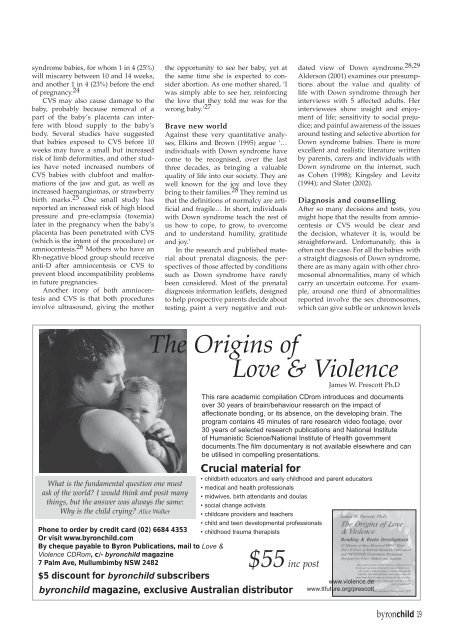byronchild - logo
byronchild - logo
byronchild - logo
You also want an ePaper? Increase the reach of your titles
YUMPU automatically turns print PDFs into web optimized ePapers that Google loves.
syndrome babies, for whom 1 in 4 (25%)<br />
will miscarry between 10 and 14 weeks,<br />
and another 1 in 4 (23%) before the end<br />
of pregnancy. 24<br />
CVS may also cause damage to the<br />
baby, probably because removal of a<br />
part of the baby’s placenta can interfere<br />
with blood supply to the baby’s<br />
body. Several studies have suggested<br />
that babies exposed to CVS before 10<br />
weeks may have a small but increased<br />
risk of limb deformities, and other studies<br />
have noted increased numbers of<br />
CVS babies with clubfoot and malformations<br />
of the jaw and gut, as well as<br />
increased haemangiomas, or strawberry<br />
birth marks. 25 One small study has<br />
reported an increased risk of high blood<br />
pressure and pre-eclampsia (toxemia)<br />
later in the pregnancy when the baby’s<br />
placenta has been penetrated with CVS<br />
(which is the intent of the procedure) or<br />
amniocentesis. 26 Mothers who have an<br />
Rh-negative blood group should receive<br />
anti-D after amniocentesis or CVS to<br />
prevent blood incompatibility problems<br />
in future pregnancies.<br />
Another irony of both amniocentesis<br />
and CVS is that both procedures<br />
involve ultrasound, giving the mother<br />
What is the fundamental question one must<br />
ask of the world? I would think and posit many<br />
things, but the answer was always the same:<br />
Why is the child crying? Alice Walker<br />
Phone to order by credit card (02) 6684 4353<br />
Or visit www.<strong>byronchild</strong>.com<br />
By cheque payable to Byron Publications, mail to Love &<br />
Violence CDRom, c/- <strong>byronchild</strong> magazine<br />
7 Palm Ave, Mullumbimby NSW 2482<br />
$5 discount for <strong>byronchild</strong> subscribers<br />
the opportunity to see her baby, yet at<br />
the same time she is expected to consider<br />
abortion. As one mother shared, ‘I<br />
was simply able to see her, reinforcing<br />
the love that they told me was for the<br />
wrong baby.’ 27<br />
Brave new world<br />
Against these very quantitative analyses,<br />
Elkins and Brown (1995) argue ‘…<br />
individuals with Down syndrome have<br />
come to be recognised, over the last<br />
three decades, as bringing a valuable<br />
quality of life into our society. They are<br />
well known for the joy and love they<br />
bring to their families. 28 They remind us<br />
that the definitions of normalcy are artificial<br />
and fragile… In short, individuals<br />
with Down syndrome teach the rest of<br />
us how to cope, to grow, to overcome<br />
and to understand humility, gratitude<br />
and joy.’<br />
In the research and published material<br />
about prenatal diagnosis, the perspectives<br />
of those affected by conditions<br />
such as Down syndrome have rarely<br />
been considered. Most of the prenatal<br />
diagnosis information leaflets, designed<br />
to help prospective parents decide about<br />
testing, paint a very negative and out-<br />
The Origins of<br />
Love & Violence<br />
James W. Prescott Ph.D<br />
This rare academic compilation CDrom introduces and documents<br />
over 30 years of brain/behaviour research on the impact of<br />
affectionate bonding, or its absence, on the developing brain. The<br />
program contains 45 minutes of rare research video footage, over<br />
30 years of selected research publications and National Institute<br />
of Humanistic Science/National Institute of Health government<br />
documents.The film documentary is not available elsewhere and can<br />
be utilised in compelling presentations.<br />
Crucial material for<br />
• childbirth educators and early childhood and parent educators<br />
• medical and health professionals<br />
• midwives, birth attendants and doulas<br />
• social change activists<br />
• childcare providers and teachers<br />
• child and teen developmental professionals<br />
• childhood trauma therapists<br />
$55 inc post<br />
<strong>byronchild</strong> magazine, exclusive Australian distributor<br />
dated view of Down syndrome. 28,29<br />
Alderson (2001) examines our presumptions<br />
about the value and quality of<br />
life with Down syndrome through her<br />
interviews with 5 affected adults. Her<br />
interviewees show insight and enjoyment<br />
of life; sensitivity to social prejudice;<br />
and painful awareness of the issues<br />
around testing and selective abortion for<br />
Down syndrome babies. There is more<br />
excellent and realistic literature written<br />
by parents, carers and individuals with<br />
Down syndrome on the internet, such<br />
as Cohen (1998); Kingsley and Levitz<br />
(1994); and Slater (2002).<br />
Diagnosis and counselling<br />
After so many decisions and tests, you<br />
might hope that the results from amniocentesis<br />
or CVS would be clear and<br />
the decision, whatever it is, would be<br />
straightforward. Unfortunately, this is<br />
often not the case. For all the babies with<br />
a straight diagnosis of Down syndrome,<br />
there are as many again with other chromosomal<br />
abnormalities, many of which<br />
carry an uncertain outcome. For example,<br />
around one third of abnormalities<br />
reported involve the sex chromosomes,<br />
which can give subtle or unknown levels<br />
www.violence.de<br />
www.ttfuture.org/prescott<br />
<strong>byronchild</strong> 19


